 | TODAY IN SCIENCE HISTORY NEWSLETTER - 7 APRIL |
| Feature for Today |
 On 7 Apr 1809, James Glaisher was born, a meteorologist who worked at the Royal Observatory, Greenwich. But his activities were far-ranging. When the British Association decided to initiate a new series of balloon ascents, he rode along on 28 of them to make scientific observations. On 7 Apr 1809, James Glaisher was born, a meteorologist who worked at the Royal Observatory, Greenwich. But his activities were far-ranging. When the British Association decided to initiate a new series of balloon ascents, he rode along on 28 of them to make scientific observations.On 5 Sep 1862, during a balloon trip made to a record height, he lost consciousness. His life was saved by his pilot, despite the disabling effects of the cold he was also suffering. Glaisher was an interesting scientist, as you will find out by reading this Obituary, (1903). |
| Book of the Day | |
| |
| Quotations for Today | |
 | "The most satisfactory definition of man from the scientific point of view is probably Man the Tool-maker." |
 | "...after my first feeling of revulsion had passed, I spent three of the most entertaining and instructive weeks of my life studying the fascinating molds which appeared one by one on the slowly disintegrating mass of horse-dung. Microscopic molds are both very beautiful and absorbingly interesting. The rapid growth of their spores, the way they live on each other, the manner in which the different forms come and go, is so amazing and varied that I believe a man could spend his life and not exhaust the forms or problems contained in one plate of manure." |
 | "Man is a megalomaniac among animals—if he sees mountains he will try to imitate them by pyramids, and if he sees some grand process like evolution, and thinks it would be at all possible for him to be in on that game, he would irreverently have to have his whack at that too. That daring megalomania of his—has it not brought him to his present place?" |
| QUIZ | |
| Before you look at today's web page, see if you can answer some of these questions about the events that happened on this day. Some of the names are very familiar. Others will likely stump you. Tickle your curiosity with these questions, then check your answers on today's web page. | |
| Births | |
 |  Kenneth Oakley, born 7 Apr 1911, was a physical anthropologist, geologist, and paleontologist best known for his work in the relative dating of fossils by analysis of the content of a certain element that that bones would gradually absorb from surrounding soil. He used this method to expose as a forgery the "Piltdown Man" skull "unearthed" in 1912, that had for decades been said to represent the "missing link" in human evolution. He proved the true age of the bones to be a modern human braincase and an orangutan jawbone. The bones of the forgery had been chemically stained to appear ancient. Kenneth Oakley, born 7 Apr 1911, was a physical anthropologist, geologist, and paleontologist best known for his work in the relative dating of fossils by analysis of the content of a certain element that that bones would gradually absorb from surrounding soil. He used this method to expose as a forgery the "Piltdown Man" skull "unearthed" in 1912, that had for decades been said to represent the "missing link" in human evolution. He proved the true age of the bones to be a modern human braincase and an orangutan jawbone. The bones of the forgery had been chemically stained to appear ancient. |
 |  Jacques Loeb, born 7 Apr 1859, was a German-born American biologist noted chiefly for his experimental work on artificial parthenogenesis, which he deomstrated with urchins and frogs. Jacques Loeb, born 7 Apr 1859, was a German-born American biologist noted chiefly for his experimental work on artificial parthenogenesis, which he deomstrated with urchins and frogs. |
| Deaths | |
 |  A French mathematician, physicist, and inventor (1746-1823) is best known for his law concerning the thermal expansion of gases that for a gas at constant pressure: its volume is directly proportional to its absolute temperature. He also was active popularizing Benjamin Franklin's theory of electricity. Further, he made several balloon ascents, was the first to use hydrogen for balloon inflation and invented most of the equipment that is still used in today's balloons. A French mathematician, physicist, and inventor (1746-1823) is best known for his law concerning the thermal expansion of gases that for a gas at constant pressure: its volume is directly proportional to its absolute temperature. He also was active popularizing Benjamin Franklin's theory of electricity. Further, he made several balloon ascents, was the first to use hydrogen for balloon inflation and invented most of the equipment that is still used in today's balloons. |
| Events | |
| |  On 7 Apr 1815, a massive volcanic eruption on an Indonesia island, made a crater five miles across, lowered the island by 4,000 feet, and killed 92,000 people. The effect was felt worldwide since the huge dust cloud ejected into the atmosphere was of such record amounts that the light of the sun was screened and the world experienced a drop in temperature. On 7 Apr 1815, a massive volcanic eruption on an Indonesia island, made a crater five miles across, lowered the island by 4,000 feet, and killed 92,000 people. The effect was felt worldwide since the huge dust cloud ejected into the atmosphere was of such record amounts that the light of the sun was screened and the world experienced a drop in temperature. What is the name of this volcano? What is the name of this volcano? |
 On 7 Apr 1795, France adopted by law, the metre as the unit of length and the base of the metric system. Since there had been no uniformity of French weights and measures prior to the Revolution, the Academy of Sciences had been charged on 8 May 1790 to organise a better system. On 7 Apr 1795, France adopted by law, the metre as the unit of length and the base of the metric system. Since there had been no uniformity of French weights and measures prior to the Revolution, the Academy of Sciences had been charged on 8 May 1790 to organise a better system.  How was the metre defined? How was the metre defined? | |
| Answers |
When you have your answers ready to all the questions above, you'll find all the information to check them, and more, on the April 7 web page of Today in Science History. Or, try this link first for just the brief answers. Fast answers for the previous newsletter for April 6: the decade including the year 1962; Harold Edgerton; biochemistry; Teflon; Kodak. |
| Feedback |
 If you enjoy this newsletter, the website, or wish to offer encouragement or ideas, please send feedback by using your mail reader Reply button. If you enjoy this newsletter, the website, or wish to offer encouragement or ideas, please send feedback by using your mail reader Reply button. |
--
If you do not want to receive any more newsletters, Unsubscribe
To update your preferences and to unsubscribe visit this link


Δεν υπάρχουν σχόλια:
Δημοσίευση σχολίου